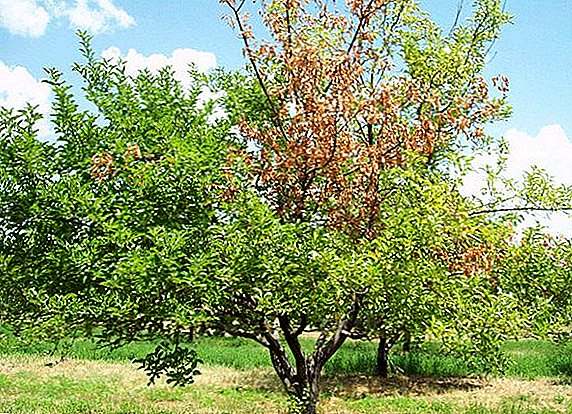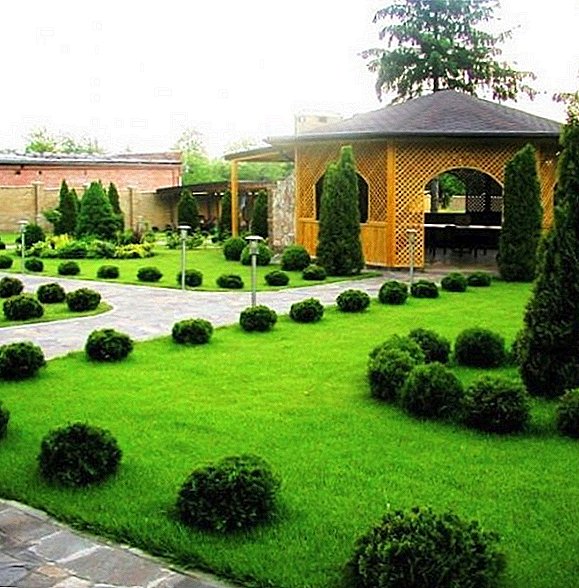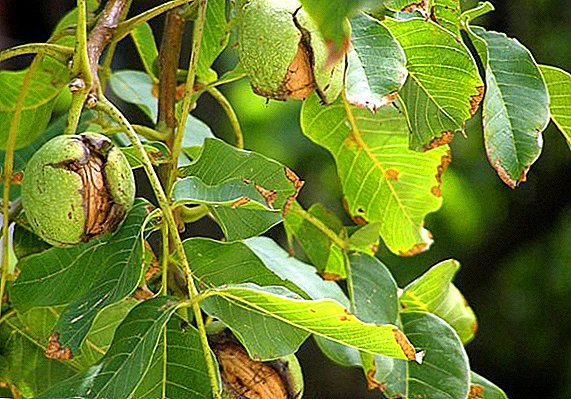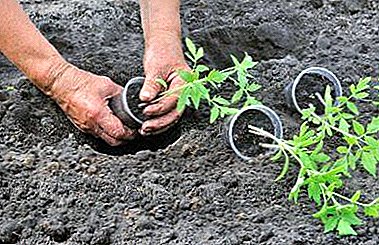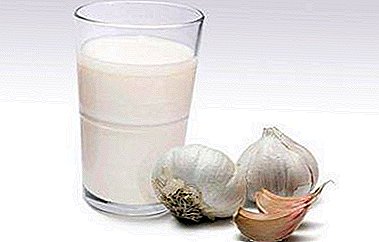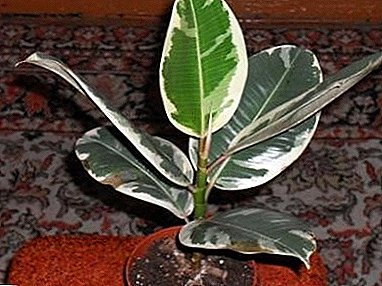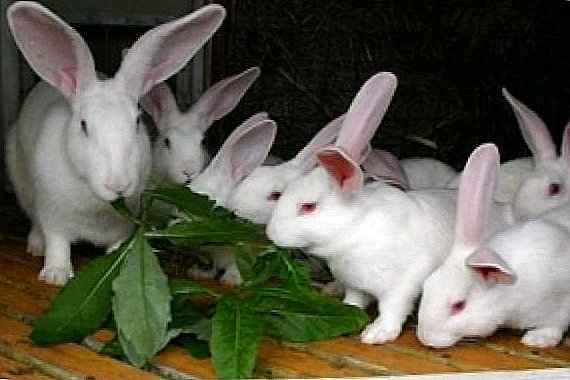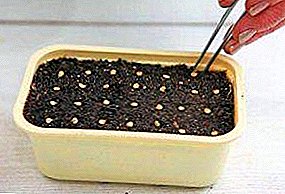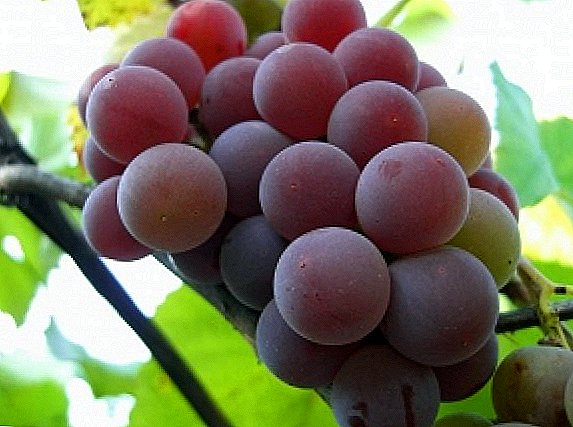
The most famous technical grape varieties that are used for winemaking are "Isabella" and "Lydia".
At the same time, the second grade often remains in the shadow, because it has a lot of similarities with Isabella, and they often call it "Pink" or "Red Isabella."
But still, the grapes "Lydia" has its own special characteristics, for which he became fond of many winegrowers as an amateur and as grapes for table use, and as an ornamental plant.
Also, the variety is characterized by a large number of healing properties.
It is about the merits and demerits of grapes "Lydia" and will be discussed below.
Description of the characteristics of "Lydia": how not to be confused with other varieties?
The grape of universal purpose called "Lydia" was introduced to the European continent as a wild culture, which was later ennobled and became a garden crop. In our time, this variety has a very wide zoning and is one of the most widespread in the south of Russia, Ukraine and Moldova.
Despite the fact that the cultivation of "Lydia" on an industrial scale is not as popular as before, but the variety is gaining popularity among fans.
Left behind for fermentation, this grape variety can release hazardous substances that are very dangerous for humans.
Distinctive features of bunches of grapes "Lydia"
The clusters in this variety have very small sizes, although they are rather attractive in appearance. The average mass of a bunch of grapes "Lydia" reaches only 100-110 grams, although of course there are larger ones. They are cylindroconic in shape, have many branches, for which reason their structure is loose. Accordingly, the berries on the clusters are also formed not large, only 3-4 grams.
The shape and size of the berries are very similar to "Isabella", but their skin color is pink, with a characteristic purple tint. The taste of the fruits of "Lydia" is special, has a pleasant taste of strawberries and a unique aroma. Because of these special taste, many do not like this variety, although for others it is the benchmark of grapes. It is worth paying and on especially high content of sugars in pulp of berries - about 18%.
Characteristic fruitful opportunities of grapes "Lydia"
High yields are the characteristic for which Lydia grapes are loved and grown on their plots by the growers. Although the fruits ripen and relatively long (removable maturity occurs after 158 days of bush vegetation, around mid-September), wait for it is really worth it.

After all, the number of well-ripened grapes on one bush, which has a growth rate above the average, can reach 120 centners per hectare. It is noted that even with one bush, which does not even require a lot of care, you can collect about 40 kilograms of an excellent harvest.
Such high rates of grape yield are possible due to the good maturity of the vine. It is also worth noting that on one shoot it can fully mature from 3 to 6 bunches. At the same time, the bush does not require rationing.
Why is the grade "Lydia" should be chosen for growing on the site?
• This variety is universal and has all the necessary parameters for the preparation of dessert wines and juices.
• The variety is not whimsical in care and has high yields.
• Mildew and powdery mildew do not affect the Lydia vine and it does not even require preventive spraying.
• The resistance of the variety to low temperatures makes it possible to grow grapes throughout Central Ukraine and even Russia.
• Characterized by the presence of a flower of both sexes, so that the grapes are able to self-pollinate.
• Crop is not afraid of high humidity.
• The bush responds very well to fertilizing with mineral and organic fertilizers.
• The peel strength ensures that Lydia grapes are suitable for transportation.
The disadvantages of grapes: the complexity of growing varieties "Lydia"
• Among the pests of vineyards, the bushes of the variety "Lydia" are most often affected by phylloxera, to which they practically have no resistance.
• With a lack of iron in the soil of a grape bush, a disease such as calcareous chlorosis can develop.
• The pacekins and shoots of the Lydia vine have very rapid growth, which can affect the decline in crop quality. Therefore, the bush requires pinching and chasing green shoots.
• It is very important to bear in mind that ripe grapes do not attach well to the stem. For this reason, with strong winds, they can break off, which requires timely removal of the crop from the bush.
• In Europe, this variety is forbidden for cultivation: if all the necessary fermentation conditions are not met, grapes can produce elements harmful to the human body that can cause multiple sclerosis. Fresh grapes are absolutely safe and healthy.

Grapes varieties "Lydia": landing on the plot
Planting grapes: spring or autumn?
Planting grapes is quite simple, although it’s still worth exploring the most important rules and features of this process. Especially a lot of nuances relate to the timing of the year for his landing. After all, they plant it both in spring and in autumn, but to figure out why some people choose one time, while others are still worth it.
1. Spring planting is usually considered more acceptable, since at this time almost all crops are planted. There is a lot of warm season ahead, for which the planted grape bush will have time to get stronger in a new place and will become much more stable when the first frosts come. Moreover, the grapes planted in the spring next year will be able to bring the first harvest. but still, such a landing has several disadvantages:
• Spring planting is carried out in a drier soil, so the sapling requires a lot of watering.
• Selecting the desired grape variety in spring nurseries is difficult, as they are more often put up for sale in the autumn.
• In spring, unexpected frosts can often appear suddenly, which can harm the green shoots of the Lydia seedling.
2. Autumn planting is essentially a way to preserve the grape seedling before the onset of spring heat. Indeed, during the winter period, the growth of the bush practically does not occur, only the root system of the seedling gradually adapts to the new conditions. Autumn planting has only one, but a very respectful flaw: winter frosts can greatly damage the seedling, so it requires good harboring.
Ways of planting Lydia grapes: which one is better to choose
The value of old grape varieties is that they can be propagated in all possible ways: sow seeds, plant seedlings and plant cuttings and use bends. In any case, due to the wide distribution of grapes "Libya", problems with the purchase of seedlings and cuttings should not arise.
Planting seedlings is by far the easiest way, although if there is a stock of an old bush, it is better to choose a graft.
When grafting, a shrub is much better and quicker to take root and grows.
What is the best place to plant grapes "Libya"?
Place for planting this grape variety should be selected for the following criteria and their features:
1. Grapes for good growth requires fertile soil. Thus, it is best to pick up black soil or light loamy soil. It is important that the soil had a good capacity for moisture, and also did not keep it in itself for too long. The optimum depth of groundwater in the area where you are going to plant grapes should be at least 1.5 meters.
2. The planting site of the Lydia vine must be well lit and not protected from cold winds through or cold air stagnation. For this reason, at home, grapes are most often planted on the south side of houses or gazebos, thus serving as an ornamental and garden plant.

3. If you are going to plant several bushes, a hundred recedes between them should be done at least 80 centimeters. The vine bush "Lydia" has a fairly strong growth and is prone to thickening, so one bush should not be allowed to shade the other.
Planting a grape sapling "Libya": what nuances should not be forgotten?
It is very important to know that the preparation of the pit for grapes is carried out much earlier than the planting itself. After all, a large amount of fertilizer and fertile soil must be brought to the bottom of the pit, which by the time of planting should settle. In particular:
• Having dug a hole with a depth and width of not less than 0.8 meters, we fall asleep at its bottom a 5-centimeter layer of fine crushed stone.
• Over it, fertile soil is poured, which we removed when we dug a hole, then organic matter and mineral fertilizers (potassium, phosphorus, iron) and again the soil.
• This whole cake should be mixed well and covered with another layer of simple soil. The fact is that if the roots of the seedling will come into contact with the fertilizers directly, they can be burnt.
• When planting in the autumn, the pit should remain in this state for at least two weeks, and in spring, during the whole winter.
Sapling before planting should be well inspected, check whether there are no damaged and dried roots. Also, before planting, the root system is placed in water for several days, and also immersed in a solution that stimulates growth and the formation of roots. The roots of the seedling can be cut a little before planting.

Placing a seedling in a pit, it is necessary to take into account the likelihood of subsidence of the soil, and lower the root neck to the level at which it will be above the soil surface. Sowing seedling soil should be carefully, not allowing the formation of air pillows in the pit. Having dug a hole with a sapling only to the middle, it is worth pouring 10 liters of water into it and driving a stake from the northern side of the seedling that will serve as a support for it. Next, we complete the burying of the pit and pour the grapes with another 30 liters of water.
After the Libya grape seedling, the soil around it should definitely be covered with mulch. It will allow moisture to persist much longer in the soil, making watering more rare.
Grafting "Lydia" on the rootstocks of other grape varieties
To plant "Lydia" on the stock, it is first of all important to select and prepare a varietal cutting. It is cut from the escape of the bush "Lydia", on which it will be enough to leave 2-3 eyes. You can save it until spring by filling it with sand and leaving it in a place with a temperature no higher than 12ºС. Before direct inoculation, the lower part of the cutting is cut: only two sides are cut off, leaving two “shoulders” in the middle.
The upper part of the cutting is waxed, which will allow it to be more resistant to weather conditions and not lose moisture. The cut-off part must always be in water and solution with a root formation stimulator (“Humate” solution) before the inoculation.
Preparation of the stock should also be thorough. First of all, the old bush is removed. After it should be only 5-8 cm penechek. Place the cut must be cleaned to smoothness, removes all dirt and debris. Only after that you need to start splitting the stock: exactly in the middle you need to make a small gap in which a cutting (or several) can fit.
The grape grafting itself consists in placing a cutting in the split (only the cut part of it) and it is firmly clamped by the stock. For this, the vaccination site is tightened with a durable tape of fabric that can decompose until next year. In order that both the stock and the stalk retain more moisture, the graft is covered with clay. The stock after the inoculation is abundantly watered, and the soil around it is dug up and mulched.
It is also interesting to read about black grapes
Caring for the vine "Lydia": how to increase the yield and quality of fruits?
A very positive effect on the growth of the vine and the formation of the crop timely watering. Due to the additional introduction of moisture during the blooming of buds and before the flowering of the bush, the bush receives much more energy and starts growing more efficiently.
After completion of flowering and during the formation of berries on the inflorescences, you need to carry out another watering of the bush. During periods of prolonged drought, the bush also cannot be left without moisture, because without it the berries will not grow to the desired size and may be acidic.
After each watering it is very important to mulch the soil around the trunk of a grape bush. Mulch serves not only to preserve moisture in the soil, but also acts as an excellent organic fertilizer. After all, humus or blackened sawdust is most often used as mulch. A layer of mulch is best done about 3 centimeters, increasing or decreasing its thickness depending on the season and temperature conditions.

The grapes "Lydia" it is important to additionally feed, making fertilizers for digging the soil or, together with irrigation, dissolving them in water.
Like any other variety, these grapes require regular pruning of shoots and sleeves. Such actions help not only to form a good bush, but also allows you to store more nutrients in it for the new crop. Such a bush, as in the variety "Lydia" should be shortened by no less than 6-8 eyes. Do not forget about cutting off stepsons and chasing the shoots of the bush, which should be carried out around mid-late June.
Despite the good stability of "Lydia" before frost, in the more northern regions the bush requires shelter for the winter. This is especially true of young and only planted bushes. Covering them, thanks to the small size, is very simple. Having established a tub without a bottom over a bush, a sapling (or graft graft) is completely covered with soil, making a hill about 10 centimeters above it.
To make such a construction stand throughout the winter, it is worth supporting it with the help of boards or fir-tree branches. If weather conditions require the shelter of an adult bush, the best option is to create a corridor over it from the film. But, with thaws, it is important to run air under it so that the bush does not stand up.
Despite the high resistance of the grapes "Lydia" to the main fungal diseases, it requires preventive measures to combat phylloxera. It is very important to spray the bush, the best preparations for which are Actellic, Zolon and Konfidor. If lesions were seen foliage - it must be cut off and destroyed. Reduces the risk of damage by this pest of planting grapes on sandy soils.



